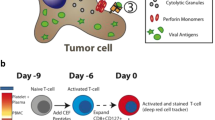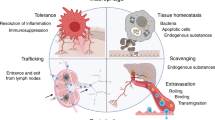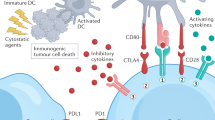Abstract
Small-molecule drugs may complement antibody-based therapies in an immune-oncology setting, yet systematic methods for the identification and characterization of the immunomodulatory properties of these entities are lacking. We surveyed the immumomodulatory potential of 1,402 small chemical molecules, as defined by their ability to alter the cell-cell interactions among peripheral mononuclear leukocytes ex vivo, using automated microscopy and population-wide single-cell image analysis. Unexpectedly, ∼10% of the agents tested affected these cell-cell interactions differentially. The results accurately recapitulated known immunomodulatory drug classes and revealed several clinically approved drugs that unexpectedly harbor the ability to modulate the immune system, which could potentially contribute to their physiological mechanism of action. For instance, the kinase inhibitor crizotinib promoted T cell interactions with monocytes, as well as with cancer cells, through inhibition of the receptor tyrosine kinase MSTR1 and subsequent upregulation of the expression of major histocompatibility complex molecules. The approach offers an attractive platform for the personalized identification and characterization of immunomodulatory therapeutics.
This is a preview of subscription content, access via your institution
Access options
Access Nature and 54 other Nature Portfolio journals
Get Nature+, our best-value online-access subscription
$29.99 / 30 days
cancel any time
Subscribe to this journal
Receive 12 print issues and online access
$259.00 per year
only $21.58 per issue
Buy this article
- Purchase on Springer Link
- Instant access to full article PDF
Prices may be subject to local taxes which are calculated during checkout






Similar content being viewed by others
References
Snijder, B. et al. Population context determines cell-to-cell variability in endocytosis and virus infection. Nature 461, 520–523 (2009).
Germain, R.N., Robey, E.A. & Cahalan, M.D. A decade of imaging cellular motility and interaction dynamics in the immune system. Science 336, 1676–1681 (2012).
Mahoney, K.M., Rennert, P.D. & Freeman, G.J. Combination cancer immunotherapy and new immunomodulatory targets. Nat. Rev. Drug Discov. 14, 561–584 (2015).
Hoos, A. Development of immuno-oncology drugs—from CTLA4 to PD1 to the next generations. Nat. Rev. Drug Discov. 15, 235–247 (2016).
Sharma, P. & Allison, J.P. The future of immune checkpoint therapy. Science 348, 56–61 (2015).
Roche, P.A. & Furuta, K. The ins and outs of MHC class II–mediated antigen processing and presentation. Nat. Rev. Immunol. 15, 203–216 (2015).
Hou, W. et al. Viral infection triggers rapid differentiation of human blood monocytes into dendritic cells. Blood 119, 3128–3131 (2012).
Germain, R.N. & Stefanová, I. The dynamics of T cell receptor signaling: complex orchestration and the key roles of tempo and cooperation. Annu. Rev. Immunol. 17, 467–522 (1999).
Wu, L.C., Tuot, D.S., Lyons, D.S., Garcia, K.C. & Davis, M.M. Two-step binding mechanism for T cell receptor recognition of peptide–MHC. Nature 418, 552–556 (2002).
Banchereau, J. & Steinman, R.M. Dendritic cells and the control of immunity. Nature 392, 245–252 (1998).
Lolekha, S., Dray, S. & Gotoff, S.P. Macrophage aggregation in vitro: a correlate of delayed hypersensitivity. J. Immunol. 104, 296–304 (1970).
Maloney, D.G., Smith, B. & Rose, A. Rituximab: mechanism of action and resistance. Semin. Oncol. 29, 2–9 (2002).
Löffler, A. et al. Efficient elimination of chronic lymphocytic leukemia B cells by autologous T cells with a bispecific anti-CD19–anti-CD3 single-chain antibody construct. Leukemia 17, 900–909 (2003).
Topp, M.S. et al. Safety and activity of blinatumomab for adult patients with relapsed or refractory B precursor acute lymphoblastic leukemia: a multicenter, single-arm, phase 2 study. Lancet Oncol. 16, 57–66 (2015).
Honke, N. et al. Enforced viral replication activates adaptive immunity and is essential for the control of a cytopathic virus. Nat. Immunol. 13, 51–57 (2011).
Hu, X., Li, W.P., Meng, C. & Ivashkiv, L.B. Inhibition of IFN-γ signaling by glucocorticoids. J. Immunol. 170, 4833–4839 (2003).
Glass, C.K. & Saijo, K. Nuclear receptor trans-repression pathways that regulate inflammation in macrophages and T cells. Nat. Rev. Immunol. 10, 365–376 (2010).
Dennis, E.A. & Norris, P.C. Eicosanoid storm in infection and inflammation. Nat. Rev. Immunol. 15, 511–523 (2015).
Harizi, H., Corcuff, J.B. & Gualde, N. Arachidonic-acid-derived eicosanoids: roles in biology and immunopathology. Trends Mol. Med. 14, 461–469 (2008).
Ben-Zvi, I., Kivity, S., Langevitz, P. & Shoenfeld, Y. Hydroxychloroquine: from malaria to autoimmunity. Clin. Rev. Allergy Immunol. 42, 145–153 (2012).
Anderson, H.A., Hiltbold, E.M. & Roche, P.A. Concentration of MHC class II molecules in lipid rafts facilitates antigen presentation. Nat. Immunol. 1, 156–162 (2000).
Komaniwa, S. et al. Lipid-mediated presentation of MHC class II molecules guides thymocytes to the CD4 lineage. Eur. J. Immunol. 39, 96–112 (2009).
Weitz-Schmidt, G. et al. Statins selectively inhibit leukocyte function antigen 1 by binding to a novel regulatory integrin site. Nat. Med. 7, 687–692 (2001).
Schindler, R., Dinarello, C.A. & Koch, K.M. Angiotensin-converting-enzyme inhibitors suppress synthesis of tumor necrosis factor and interleukin 1 by human peripheral blood mononuclear cells. Cytokine 7, 526–533 (1995).
Flaishon, L. et al. Expression of the chemokine receptor CCR2 on immature B cells negatively regulates their cytoskeletal rearrangement and migration. Blood 104, 933–941 (2004).
Rice-Evans, C.A., Miller, N.J., Bolwell, P.G., Bramley, P.M. & Pridham, J.B. The relative antioxidant activities of plant-derived polyphenolic flavonoids. Free Radic. Res. 22, 375–383 (1995).
Khajanchi, B.K., Kirtley, M.L., Brackman, S.M. & Chopra, A.K. Immunomodulatory and protective roles of quorum-sensing signaling molecules N-acyl homoserine lactones during infection of mice with Aeromonas hydrophila. Infect. Immun. 79, 2646–2657 (2011).
Ritchie, A.J. et al. The Pseudomonas aeruginosa quorum-sensing molecule N-3-(oxododecanoyl)-L-homoserine lactone inhibits T cell differentiation and cytokine production by a mechanism involving an early step in T cell activation. Infect. Immun. 73, 1648–1655 (2005).
Elenkov, I.J., Wilder, R.L., Chrousos, G.P. & Vizi, E.S. The sympathetic nerve—an integrative interface between two supersystems: the brain and the immune system. Pharmacol. Rev. 52, 595–638 (2000).
Alam, S., Laughton, D.L., Walding, A. & Wolstenholme, A.J. Human peripheral blood mononuclear cells express GABAA receptor subunits. Mol. Immunol. 43, 1432–1442 (2006).
Bhat, R. et al. Inhibitory role for GABA in autoimmune inflammation. Proc. Natl. Acad. Sci. USA 107, 2580–2585 (2010).
Tian, J., Yong, J., Dang, H. & Kaufman, D.L. Oral GABA treatment downregulates inflammatory responses in a mouse model of rheumatoid arthritis. Autoimmunity 44, 465–470 (2011).
Sanders, V.M. The β2-adrenergic receptor on T and B lymphocytes: do we understand it yet? Brain Behav. Immun. 26, 195–200 (2012).
Loza, M.J., Foster, S., Peters, S.P. & Penn, R.B. β-agonists modulate T cell functions via direct actions on type 1 and type 2 cells. Blood 107, 2052–2060 (2006).
Heine, A., Held, S.A., Bringmann, A., Holderried, T.A. & Brossart, P. Immunomodulatory effects of anti-angiogenic drugs. Leukemia 25, 899–905 (2011).
Santoni, M. et al. Role of natural and adaptive immunity in renal cell carcinoma response to VEGFR-TKIs and mTOR inhibitor. Int. J. Cancer 134, 2772–2777 (2014).
Cui, J.J. et al. Structure-based drug design of crizotinib (PF-02341066), a potent and selective dual inhibitor of mesenchymal-epithelial transition factor (c-MET) kinase and anaplastic lymphoma kinase (ALK). J. Med. Chem. 54, 6342–6363 (2011).
Kobayashi, K.S. & van den Elsen, P.J. NLRC5: a key regulator of MHC class I–dependent immune responses. Nat. Rev. Immunol. 12, 813–820 (2012).
Sharma, P. & Allison, J.P. Immune checkpoint targeting in cancer therapy: toward combination strategies with curative potential. Cell 161, 205–214 (2015).
Moreno, C.S., Beresford, G.W., Louis-Plence, P., Morris, A.C. & Boss, J.M. CREB regulates MHC class II expression in a CIITA-dependent manner. Immunity 10, 143–151 (1999).
Huber, K.V.M. et al. Stereospecific targeting of MTH1 by (S)-crizotinib as an anticancer strategy. Nature 508, 222–227 (2014).
Davis, M.I. et al. Comprehensive analysis of kinase inhibitor selectivity. Nat. Biotechnol. 29, 1046–1051 (2011).
Christensen, J.G. et al. Cytoreductive antitumor activity of PF-2341066, a novel inhibitor of anaplastic lymphoma kinase and c-Met, in experimental models of anaplastic large-cell lymphoma. Mol. Cancer Ther. 6, 3314–3322 (2007).
Wilson, C.B. et al. The RON receptor tyrosine kinase regulates IFN-γ production and responses in innate immunity. J. Immunol. 181, 2303–2310 (2008).
Eyob, H. et al. Inhibition of Ron kinase blocks conversion of micrometastases to overt metastases by boosting antitumor immunity. Cancer Discov. 3, 751–760 (2013).
Mallakin, A. et al. Gene expression profiles of Mst1r-deficient mice during nickel-induced acute lung injury. Am. J. Respir. Cell Mol. Biol. 34, 15–27 (2006).
Schroeder, G.M. et al. Discovery of N-(4-(2-amino-3-chloropyridin-4-yloxy)-3-fluorophenyl)-4-ethoxy-1-(4-fluorophenyl)-2-oxo-1,2-dihydropyridine-3-carboxamide (BMS-777607), a selective and orally efficacious inhibitor of the Met kinase superfamily. J. Med. Chem. 52, 1251–1254 (2009).
Lovly, C.M. et al. Rationale for co-targeting IGF-1R and ALK in ALK-fusion-positive lung cancer. Nat. Med. 20, 1027–1034 (2014).
Knight, Z.A., Lin, H. & Shokat, K.M. Targeting the cancer kinome through polypharmacology. Nat. Rev. Cancer 10, 130–137 (2010).
Zhang, J., Yang, P.L. & Gray, N.S. Targeting cancer with small-molecule kinase inhibitors. Nat. Rev. Cancer 9, 28–39 (2009).
Fellmann, C. et al. An optimized microRNA backbone for effective single-copy RNAi. Cell Rep. 5, 1704–1713 (2013).
Kim, D. et al. TopHat2: accurate alignment of transcriptomes in the presence of insertions, deletions and gene fusions. Genome Biol. 14, R36 (2013).
Trapnell, C. et al. Differential analysis of gene regulation at transcript resolution with RNA-seq. Nat. Biotechnol. 31, 46–53 (2012).
Trapnell, C. et al. Transcript assembly and quantification by RNA-seq reveals unannotated transcripts and isoform switching during cell differentiation. Nat. Biotechnol. 28, 511–515 (2010).
Winter, G.E. et al. Systems-pharmacology dissection of a drug synergy in imatinib-resistant CML. Nat. Chem. Biol. 8, 905–912 (2012).
Rämö, P., Sacher, R., Snijder, B., Begemann, B. & Pelkmans, L. CellClassifier: supervised learning of cellular phenotypes. Bioinformatics 25, 3028–3030 (2009).
Acknowledgements
We are grateful to the donors and patients for their part in this study. Our screening compound libraries are from the US National Institutes of Health clinical collection or as gifts from F. Bracher, T. Nielsen, S. Nijman, J. Bradner, the Broad Institute and Haplogen GmbH. JQ1 was provided by S. Knapp (University of Oxford), and H3122 cells and SW480 cells were kind gifts from E. Haura (Moffitt Cancer Center) and W. Berger (Medical University of Vienna), respectively. We thank M. Rebsamen, A. Fauster, G. Jurisic, A. César-Razquin, C.C. West, E. Girardi and G. Winter for assistance and critical reading of the manuscript and members of G.S.-F.'s laboratory for scientific discussions. CeMM is supported by the Austrian Academy of Sciences. We acknowledge funding from an ERC i-FIVE Advanced Investigator Grant (G.S.-F.), Austrian Science Fund grant F4711-B20 (G.S.-F.), the Austrian Federal Ministry of Science, Research and Economy (S.K.), the National Foundation for Research, Technology and Development (S.K.), the Swedish Cancer Society (T.H.), the Knut and Alice Wallenberg Foundation (T.H.), the Torsten and Ragnar Söderberg Foundation (T.H.), Swiss National Science Foundation Fellowships (P300P3_147897 (B.S.), PP00P3_163961 (B.S.) and P2EZP3_159114 (N.K.)), an EMBO long-term Fellowship (1543-2012; G.I.V.) and a Marie-Sklodowska Curie Action Fellowship (SLIM; N.K.).
Author information
Authors and Affiliations
Contributions
G.I.V., B.S., N.K., J.W.B., K.V.M.H., C.-H.L., K.S., A.R., U.W.B. and M.S. performed the experiments; P.K. and U.J. organized the clinical samples; S.K. and O.L.d.l.F. provided reagents and intellectual contributions; P.K., U.J., T.H. and G.S.-F. were responsible for human and animal ethical guidelines; G.S.-F. oversaw the project; and B.S., G.I.V. and G.S.-F. analyzed the data and wrote the manuscript.
Corresponding author
Ethics declarations
Competing interests
The spatial screening and interaction score for use in immunomodulatory drug discovery is patent-pending (WO2016046346) with G.I.V., B.S. and G.S.-F. listed as inventors. The patent is licensed to Allcyte GmbH (Vienna, Austria), which G.I.V., B.S., N.K. and G.S.-F. have co-founded.
Supplementary information
Supplementary Text and Figures
Supplementary Results, Supplementary Tables 1 and 2, and Supplementary Figures 1–6. (PDF 4603 kb)
Supplementary Dataset 1
Overview of 1,402 compounds used for screens. (XLSX 185 kb)
Supplementary Dataset 2
Resource: immune modulation potential of 1,402 compounds on key lymphocyte population interaction changes. (XLSX 243 kb)
Supplementary Dataset 3
RNA sequencing data from SW480 crizotinib treated cells. (XLSX 3984 kb)
Rights and permissions
About this article
Cite this article
Vladimer, G., Snijder, B., Krall, N. et al. Global survey of the immunomodulatory potential of common drugs. Nat Chem Biol 13, 681–690 (2017). https://doi.org/10.1038/nchembio.2360
Received:
Accepted:
Published:
Issue Date:
DOI: https://doi.org/10.1038/nchembio.2360
This article is cited by
-
Ex vivo drug response heterogeneity reveals personalized therapeutic strategies for patients with multiple myeloma
Nature Cancer (2023)
-
Proteogenetic drug response profiling elucidates targetable vulnerabilities of myelofibrosis
Nature Communications (2023)
-
A physical wiring diagram for the human immune system
Nature (2022)
-
Blocking of the PD-1/PD-L1 interaction by a novel cyclic peptide inhibitor for cancer immunotherapy
Science China Life Sciences (2021)
-
Combined chemosensitivity and chromatin profiling prioritizes drug combinations in CLL
Nature Chemical Biology (2019)



